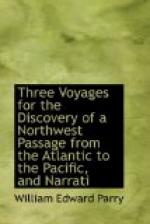Of their mode of killing seals in the winter I have already spoken in the course of the foregoing narrative, as far as we were enabled to make ourselves acquainted with it. In their summer exploits on the water, the killing of the whale is the most arduous undertaking which they have to perform; and one cannot sufficiently admire the courage and activity which, with gear apparently so inadequate, it must require to accomplish this business. Okotook, who was at the killing of two whales in the course of a single summer, and who described the whole of it quite con amore, mentioned the names of thirteen men who, each in his canoe, had assisted on one of these occasions. When a fish is seen lying on the water, they cautiously paddle up astern of him, till a single canoe, preceding the rest, comes close to him on one quarter, so as to enable the man to drive the katteelik into the animal with all the force of both arms. This having the siatko, a long allek, and the inflated sealskin attached to it, the whale immediately dives, taking the whole apparatus with him except the katteelik, which, being disengaged in the manner before described, floats to the surface, and is picked up by its owner. The animal reappearing after some time, all the canoes again paddle towards him, some warning being given by the sealskin buoy floating on the surface. Each man being furnished like the first, they repeat the blows as often as they find opportunity, till perhaps, every line has been thus employed. After pursuing him in this manner sometimes for half a day, he is at length so wearied by the resistance of the buoys, and exhausted by the loss of blood, as to be obliged to rise more and more often to the surface, when, by frequent wounds with their spears, they succeed in killing him, and tow their prize in triumph to the shore.
In attacking the walrus in the water they use the same gear, but much more caution than with the whale, always throwing the katteelik from some distance, lest the animal should attack the canoe and demolish it with his tusks. The walrus is, in fact, the only animal with which they use any caution of this kind. They like the flesh better than that of the seal; but venison is preferred by them to either of these, and, indeed, to any other kind of meat.
At Winter Island they carefully preserved the heads of all the animals killed during the winter, except two or three of the walrus, which we obtained with great difficulty. As the blood of the animals which they kill is all used as food of the most luxurious kind, they are careful to avoid losing any portion of it; for this purpose they carry with them on their excursions a little instrument of ivory called t~oop=o=ot~a, in form and size exactly resembling a “twenty-penny” nail, with which they stop up the orifice made by the spear, by thrusting it through the skin by the sides of the wound, and securing it with a twist.




